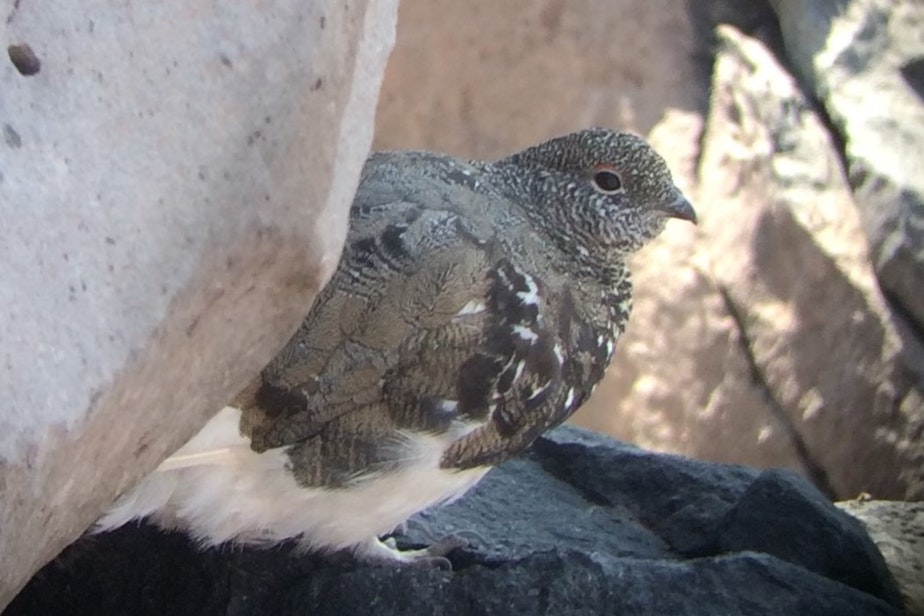Mount Rainier's chubby snowbird is now a threatened species

A chubby bird that lives year-round in some of the Pacific Northwest’s most pristine habitats has been added to the nation’s roster of threatened species.
The Mount Rainier white-tailed ptarmigan makes its home in alpine tundra and high mountain meadows above treeline in Washington and British Columbia.
The ptarmigan’s uncanny camouflage — its mottled brown plumage turns pure white in winter — hides it from predators, and its habitat is mostly congressionally designated wilderness, off-limits to most types of human disturbance.
But no disguise or land designation can protect rare species from a rapidly changing climate.
The U.S. Fish and Wildlife Service has declared the Mount Rainier white-tailed ptarmigan, one of five subspecies of the mountain-dwelling camouflage artist, a threatened species.
“The effects of climate change are already evident in Mount Rainier white-tailed ptarmigan habitat, and the likely projected future increase in the scope, magnitude, and intensity of those effects will decrease the viability of the subspecies,” the agency’s decision states in the Federal Register.
Sponsored
When the thermometer hits 70 degrees, ptarmigans pant to avoid overheating.
“Rising temperatures associated with climate change are expected to have direct and rapid impacts on individual birds,” the agency concluded.
Under federal law, a “threatened” species is not currently in danger of extinction like an “endangered” species but is likely to become in danger of extinction in the foreseeable future.
The Fish and Wildlife Service concluded that the ptarmigan could lose 90% of its snowy habitat as the world’s fossil-fuel pollution keeps heating up Washington’s mountains in decades ahead.
A white-tailed ptarmigan clucks and screams at Mount Rainier National Park. Recorded by Charlie Wright in 2009.
A white-tailed ptarmigan clucks and screams at Mount Rainier National Park. Recorded by Charlie Wright in 2009.
Ptarmigans are exquisitely adapted to cold and snow and struggle with warmth.
Their heavily feathered feet act like snowshoes, letting them walk atop deep powder.
But hotter summers and shorter winters mean less snowpack.
Trees are spreading into the alpine meadows where ptarmigans eat huckleberries and heather.
Less snow means less ptarmigan habitat and more trouble for salmon, hydropower customers, and wildland firefighters.
Sponsored
Unlike the snow, that trouble is expected to get deeper until the world reins in its fossil-fuel pollution.

The white-tailed ptarmigan — Washington’s smallest grouse and its only ptarmigan — has been a rare bird in the state for a long time.
Environmentalists at the Center for Biological Diversity petitioned the federal government in 2010 to protect white-tailed ptarmigan subspecies in Washington and Colorado.
“Our world is changing and changing fast,” petition author Noah Greenwald said in a Center for Biological Diversity press release. “The Service continues to move at a glacial pace to protect species like this highly imperiled bird. The agency desperately needs an overhaul to make sure we don’t lose so many vulnerable plants and animals.”
Sponsored
Tacoma birdwatcher Charlie Wright hiked into the high country around Mount Rainier and other alpine destinations in Washington 10 times, looking specifically for ptarmigans.
He said the bird is like a holy grail for birders.
“It’s one of the most challenging breeding birds in Washington, one that requires a fair amount of determined effort to lay eyes on,” Wright said by email.
On his eleventh ptarmigan quest, 20 years ago, he finally saw one.
“I have found them a number of times over the years, but that’s out of a great number more unsuccessful attempts!” he said.
Sponsored
Four subspecies of the white-tailed ptarmigan live in other parts of the U.S. and Canada.
The ptarmigan’s other subspecies live in Alaska, Colorado, the northern Rockies, and on Canada’s Vancouver Island. None have gained federal protection.
The Center for Biological Diversity sought federal protection for the Colorado-based “southern” subspecies as well as the Mount Rainier subspecies in 2010. The Fish and Wildlife Service under the Trump Administration rejected the group’s petition for the southern white-tailed ptarmigan in 2020, concluding that its risk of extinction was low.





